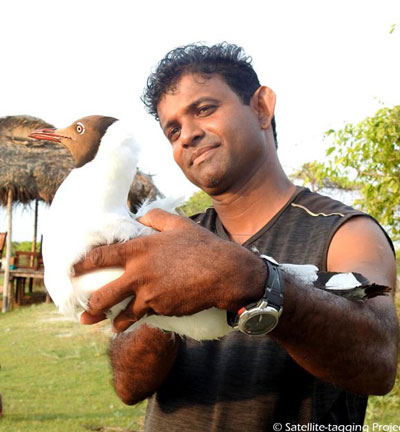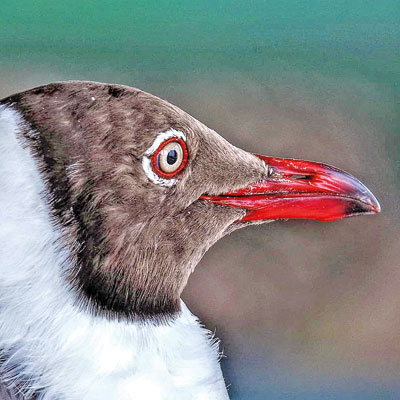News
High above icy peaks, a bird tagged in Mannar makes a heroic flight

Dr. Sampath Senevirathne before releasing the tagged Brown-headed Gull
A common bird found in coastal Sri Lanka during the early part of the year has for the first time been tracked on its heroic flight high above the Himalayan mountains after being fitted with an electronic tag by researchers in Mannar.
“The tagged brown-headed gull crossed the Himalaya range flying at an altitude of 18,153 feet (5,533m). It had to fly even higher on its last stretches of the flight over the Tibetan Plateau, reaching heights of 21,140ft (6,443m)” researcher Dr. Sampath Seneviratne said.
The brown-headed gull (Chroicocephalus brunnicephalus) was caught and tagged in April by Dr. Seneviratne’s team in Mannar. The electronic tag emits signals giving the bird’s location wherever it flies. The signals are picked up by satellite.
The gull left Sri Lanka a few days after being tagged and continued to fly northward toward its breeding ground. It could be a journey this brown-headed gull had already made a few times previously but, on this occasion, it left an electronic trail revealing its heroic flight.
According to the data, the gull crossed the Himalayan range, flying between the mountains of Manaslu (8,163m) and Nemjung (7,140m), in the first week of May and settled on the Tibetan plateau to breed.
Himalaya, with its tall mountain ranges, Everest the highest at 8,849m, is known as the roof of the world. Gusty winds, subzero temperatures and low oxygen levels make survival a challenge there, which makes the journey of the brown-headed gull so marvellous.
Ornithologists have found through visual observation that bar-headed geese fly across Himalaya. More recently, the demoiselle crane and steppe eagle have also been recorded there. The record of the brown-headed gull is only the third confirmed by tagging, Dr. Seneviratne said.

The tagged Brown-headed gull
The satellite tagging project is a joint collaboration between the Field Ornithology Group of Sri Lanka (FOGSL) based at the University of Colombo, the Chinese Academy of Sciences (CAS) and Wetlands International, with support from local sponsors. CAS provides the satellite tags and associated technology to FOGSL, which selected Mannar as the project site as it is a hotspot for migratory birds coming to Sri Lanka.
Traditionally, bird rings are used to monitor bird movements. A plastic or metal ring with a unique coding that helps to identify the place of the bird’s origin is put on a bird’s leg. When the bird wearing this ring is found in a different location it confirms the bird has travelled from one of these locations to the other.
“But these traditional rings do not reveal the movements of the bird in between, so the satellite tags and other electronic tags revolutionised migratory studies,” Professor Sarath Kotagama said.
Prof. Kotagama started the National Bird-Ringing Programme in 2004 through FOGSL in collaboration with the Department of Wildlife Conservation.
As the technology behind electronic tags is expensive, Dr. Seneviratne spent years pursuing a partner to initiate a satellite-tagging programme. Finally, the Chinese Academy of Sciences partnered with FOGSL to provide the technology and the satellite tags to begin the project last year in Mannar.
These tags use a GPS/GSM transmitter to send information about the location of the bird, its speed, and the height of its flight. The data is received and distributed through servers using the earth’s mobile networks.
Gayomini Panagoda, a Ph.D. candidate of the University of Colombo, who is using the tagging project as her thesis, says there is careful selection of the bird species to be tagged.
The team received 35 tags last year. The birds selected included the Eurasian wigeon, common redshank, whimbrel, crab plover, bar-tailed godwit, black-tailed godwit and the Caspian tern).
One bird that was tagged, the Heuglin’s gull, is regarded as special by the team. “It breeds on the rim of the Arctic in northern Siberia in Russia, so we wanted to tag this bird to study its migratory routes,” Ms Panagoda said.
“The Heuglin’s gull flew about 8,000km in 35 days to reach its breeding grounds and is now on its return journey back toward Sri Lanka for this migratory season.”
The Central Asian Flyway (CAF) is a route for migratory birds coming from areas between the Arctic and Indian oceans, and Sri Lanka is the last landmass on the southern boundaries of this flyway.
“The boundaries of the CAF are only broadly defined and poorly understood, so we aim for species that represent … the species that visit us from both the high Arctic and temperate latitudes to capture the full spectrum of migration systems within the flyway” Prof. Seneviratne said.
Ms. Panagoda said the team received a second batch of 35 tags for this season of migrants, and have already begun work.
The second of the World Migratory Bird Days (WMBD) yesterday marked the arrival in countries such as Sri Lanka of birds arriving from northern climes to “winter” in warm countries.
The second Saturday in May marks the other bird day, when migratory birds fly to northern regions of the world.
The theme for yesterday’s event was “Sing, fly, soar – like a bird!”, focusing on the phenomena of birdsong” and bird flight as a way to inspire and connect people around the globe in a desire to protect migratory birds.
Climate change is adding pressure on migratory birds by adversely affecting the habitats they need for breeding, resting and refuelling along the way.
Mid-October is when common migratory birds such as the Indian pitta (known as avichchiya in Sinhala) come to Sri Lanka. As it is a bulky bird, many become exhausted and ended up disoriented in many home gardens.The Field Ornithology Group of Sri Lanka (FOGSL) is holding a lecture on October 16 to educate people on what to do if an exhausted migrant is found in home gardens. Email migrantwatch.srilanka@gmail.com to register for the lecture.
| Saturday marked migration season in south The second of the World Migratory Bird Days (WMBD) yesterday, marked the arrival in countries such as Sri Lanka of birds from northern climes to “winter” in warm countries. The second Saturday in May marks the other bird day, when migratory birds fly to northern regions of the world. The theme for yesterday’s event was “Sing, fly, soar – like a bird!”, focusing on the phenomena of birdsong” and bird flight as a way to inspire and connect people around the globe in a desire to protect migratory birds. Climate change is adding pressure on migratory birds by adversely affecting the habitats they need for breeding, resting and refuelling along the way. Mid-October is when common migratory birds such as the Indian pitta (known as avichchiya in Sinhala) come to Sri Lanka. As it is a bulky bird, many become exhausted and ended up disoriented in many home gardens. The Field Ornithology Group of Sri Lanka (FOGSL) is holding a lecture on October 16 to educate people on what to do if an exhausted migrant is found in home gardens. Email migrantwatch.srilanka@gmail.com to register for the lecture. | |

